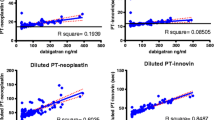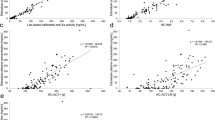Abstract
Background: Enoxaparin is increasingly used for the anticoagulation of patients undergoing percutaneous coronary intervention (PCI). Several reports have suggested the utility of using point of care tests in monitoring the anticoagulation levels of enoxaparin in patients undergoing PCI. The objective of this study was to evaluate a new point-of-care test (POCT) HEMONOX™ in monitoring the anticoagulant effect of enoxaparin in non citrated fresh whole blood samples from patients undergoing elective PCI procedure.
Methods: Following IRB approval, blood samples were obtained from fifty-four patients who received two sequential intravenous doses of enoxaparin; 0.1 mg/kg followed 5 min later by 0.4 mg/kg for a total of 0.5 mg/kg. Blood was drawn at baseline and at 5, 10, 30 and 60 min post first bolus for evaluation in the clot-based POCT HEMONOX, ACT and aPTT and the chromogenic anti-Xa activity assay.
Results: HEMONOX clotting time (CT) at baseline was 62.6 ± 6.2 secs, (n = 32) in healthy donors and statistically higher in PCI patients (71.6 ± 9.1 secs, p = 0.0001). The peak HEMONOX response that was always achieved at 10 min post bolus was >100 secs in all 54 patients, of these 83% yielded CT >150 secs (range: 150–466). There was no detectable anti-Xa activity level at baseline while peak HEMONOX CT corresponded to therapeutic levels (0.85 ± 0.14 U/ml; range: 0.61–1.34). Both HEMONOX CT and anti-Xa level significantly decreased at the time of sheath removal. HEMONOX CT at peak response suggested 3 patient subgroups with different levels of sensitivity to enoxaparin: low, intermediate and high responders. The correlation between anti-Xa activity level and HEMONOX CT was ≥0.85 in each patient subgroup when data from the 3 critical time points; baseline (absence of drug), peak response (10 min post bolus) and sheath removal (60 min post bolus) were analyzed. The correlation diminished to ≥0.83 when the analyses included data from all 5 time points [baseline, 5, 10, 30, and 60 min post bolus]. The HEMONOX test was the most sensitive POCT to measure the anticoagulant effects of enoxaparin. All patients completed PCI successfully.
Conclusion: The HEMONOX test may be able to guide anticoagulation with enoxaparin during PCI.
Abbreviated abstract
The HEMONOX assay is a one step whole blood coagulation test performed on the HEMOCHRON® Jr. Signature + POC system. The method was evaluated to monitor the anticoagulant level of enoxaparin in blood samples from patients undergoing PCI after receiving an intravenous dose of 0.5 mg/kg. The results suggest a clear distinction of HEMONOX CT between the baseline value of untreated patients and patients achieving therapeutic enoxaparin levels.
Similar content being viewed by others
References
Cohen M, Demers C, Gurfinkel EP, et al. (1997) A comparison of low-molecular-weight heparin with unfractionated heparin for unstable coronary artery disease. Efficacy and Safety of Subcutaneous Enoxaparin in Non-Q-Wave Coronary Events Study Group (ESSENCE). N Engl J Med 337:447–452
Antman EM, McCabe CH, Gurfinkel EP, et al. (1999) Enoxaparin prevents death and cardiac ischemic events in unstable angina/non-Q-wave myocardial infarction. Results of the thrombolysis in myocardial infarction TIMI-11B trial. Circulation 100:1593–1601
Goodman SG, Fitchett D, Armstrong PW, Langer A (2003) On behalf of the INTERACT Trial Investigators. The INTegrelin and Enoxaparin Randomized assessment of Acute Coronary syndrome Treatment Trial. Circulation 107:238–244
Cohen M (2003) The role of low-molecular-weight heparin in the management of acute coronary syndromes. J Am Coll Cardiol 41:55S–561S
Klein W, Buchwald A, Hillis WS, et al. (1997) Fragmin in unstable angina pectoris or in non-Q-wave acute myocardial infarction (the FRIC study). Fragmin in Unstable Coronary Artery Disease. Circulation 4;80:30E–34E
Collet JP, Montalescot G, Lison L, et al. (2001) Percutaneous coronary intervention after subcutaneous enoxaparin pretreatment in patients with unstable angina pectoris. Circulation 103:658–663
Fox KAA, Antman EM, Cohen M, Bigonzi F (2002) For the ESSENCE/TIMI 11B Investigators. Comparison of enoxaparin versus unfractionated heparin in patients with unstable angina pectoris/non-ST-segment elevation acute myocardial infarction having subsequent percutaneous coronary intervention. Am J Cardiol 90:47–82
Aslam MS, Sundberg S, Sabri MN, Cooke D, Lakier JB (2002) Pharmacokinetic of intravenous/subcutaneous Enoxaparin in patients with acute coronary syndrome undergoing percutaneous coronary interventions. Catheter Cardiovasc Interv 57:187–190
Ferguson JJ, Antman EM, Bates ER, et al. (2003) Combining enoxaparin and glycoprotein IIb/IIIa antagonists for the treatment of acute coronary syndromes: final results of the National Investigators Collaborating on Enoxaparin-3 (NICE-3) study. Am Heart J 146:628–634
Lee DS, Bhatt DL, Moliterno DJ, Peacock WF, Ellis SG, Topol EJ (2004) The combination of enoxaparin, glycoprotein IIb/IIIa inhibitors and an early invasive approach among acute coronary syndrome patients. J Invasive Cardiol 16:46–51
Ferguson JJ, Califf RM, Antman EM, et al. (2004) Enoxaparin vs. unfractionated heparin in high-risk patients with non-ST-segment elevation acute coronary syndromes managed with an intended early invasive strategy: primary results of the SYNERGY randomized trial. JAMA 292:45–54
Rabah MM, Premmereur J, Graham M, et al. (1999) Usefulness of intravenous enoxaparin for percutaneous coronary intervention in stable angina pectoris. Am J Cardiol 84:139–195
Kereiakes DJ, Grines C, Fry E, et al. (2001) For the National Investigators Collaborating on Enoxaparin. Enoxaparin and abciximab adjunctive pharmacotherapy during percutaneous coronary intervention: The NICE 1 and NICE 4 trials. J Invasive Cardiology 13:272–278
Chen WH, Lau CP, Lau YK, et al. (2002) Stable and optimal anticoagulation is achieved with a single dose of intravenous enoxaparin in patients undergoing percutaneous coronary intervention. J Invasive Cardiol 14:439–442
Choussat R, Montalescot G, Collet JP, et al. (2002) A unique, low dose of intravenous enoxaparin in elective percutaneous coronary intervention. J Am Coll Cardiol 40:1943–1950
Wong GC, Giugliano RP, Antman EM (2003) Use of low-molecular-weight heparins in the management of acute coronary artery syndromes and percutaneous coronary intervention. JAMA 289:331–342
Bhatt DL, Lee BI, Casterella PJ, et al. (2003) Safety of concomitant therapy with eptifibatide and enoxaparin in patients undergoing percutaneous coronary intervention: results of the Coronary Revascularization Using Integrilin and Single bolus Enoxaparin Study. J Am Coll Cardiol 41:20–25
Carnendran L, Borkowski R, Markabawi B, Warner MF (2003) Safety and efficacy of low-dose intravenous enoxaparin and GPIIb/IIIa inhibitor therapy during PCI. J Invasive Cardiol 15:235–238
Martin JL, Fry ET, Sanderink GJ, et al. (2004) Reliable anticoagulation with enoxaparin in patients undergoing percutaneous coronary intervention: The pharmacokinetics of enoxaparin in PCI (PEPCI) study. Catheter Cardiovasc Interv 61:163–170
Cziraky MJ, Spinler SA (1993) Low-molecular-weight heparins for the treatment of deep-vein thrombosis. Clin Pharm 12:892–899
Ramacciotti E, Araujo GR, Lastoria S, et al. (2004) An open-label, comparative study of the efficacy and safety of once-daily dose of enoxaparin versus unfractionated heparin in the treatment of proximal lower limb deep-vein thrombosis. ThrombRes. 143:149–153
Marmur JD, Anand SX, Bagga RS, et al. (2003) The activated clotting time can be used to monitor the low molecular weight heparin dalteparin after intravenous administration. J Am Coll Cardiol 41:394–403
Lawrence M, Mixon TA, Cross D, Gantt DS, Dehmer GJ (2004) Assessment of anticoagulation using activated clotting times in patients receiving intravenous enoxaparin during percutaneous coronary intervention. Catheter Cardiovasc Interv 61:52–55
Graf J, Janssens U (2004) Low-molecular weight heparins in percutaneous coronary interventions: current concepts, problems, and perspectives. Curr Pharm Des 10:375–386
Moliterno DJ, Hermiller JB, Kereiakes DJ, et al. (2003) A novel point-of-care enoxaparin monitor for use during percutaneous coronary intervention. Results of the Evaluating Enoxaparin Clotting Times (ELECT) Study. J Am Coll Cardiol 42:1132–1139
Saw J, Kereiakes DJ, Mahaffey KW, et al. (2003) Evaluation of a novel point-of-care enoxaparin monitor with central laboratory anti-Xa levels. ThrombRes. 112:301–306
Hoppensteadt DA, Jeske W, Fareed J, Bermes EW Jr (1995) The role of tissue factor pathway inhibitor in the mediation of the antithrombotic actions of heparin and low-molecular-weight heparin. Blood Coagul Fibrinolysis (Suppl-1):S57–64
(1997) Dose-ranging trial of enoxaparin for unstable angina: results of TIMI 11A. The Thrombolysis in Myocardial Infarction (TIMI) 11A Trial Investigators. J Am Coll Cardiol 7:1474–1482
Leizorovicz A, Bara L, Samama MM, Haugh MC (1993) Factor Xa inhibition: Correlation between the plasma levels of anti-Xa activity and occurrence of thrombosis and haemorrhage. Haemostasis 23(Suppl 1):89–98
Glenn NL, Fernando T (2004) Degree of anticoagulation after one subcutaneous and one subsequent intravenous booster dose of enoxaparin: implications for patients with acute coronary syndromes undergoing early percutaneous coronary intervention. J Thromb Thrombolysis 17:167–171
Sie P, Aillaud MF, de Prost D, et al. (1987) Measurement of low molecular weight heparin ex vivo activities in clinical laboratories using various anti-Xa assays: inter laboratory variability and requirement for an agreed low molecular weight heparin standard. Thromb Haemost 58:879–883
Depasse F, Gilbert M, Goret V, Rolland N, Samama MM (2000) Anti-Xa monitoring: inter-assay variability. Thromb Haemost 84:1122–1123
Kovacs MJ, Keeney M (2000) Inter-assay and instrument variability of anti-Xa results. Thromb Haemost. 84:138
Gosselin RC, King JH, Janatpour KA, Dager WE, Larkin EC, Owings JT (2004) Variability of plasma anti-Xa activities with different lots of enoxaparin. Ann Pharmacother 38:563–568
Cohen M, Gonzales A, El Rouby S, et al. (2004) Monitoring of Enoxaparin during Interventional Coronary Procedures Using a HEMOCHRON® Jr. HemonoxTM Point of Care Assay. Catheterization and Cardiovascular Interventions 62 No 1 Abstract #C12
Holmes MB, Schneider DJ, Hayes MG, Sobel BE, Mann KG (2000) Novel, bedside, tissue factor-dependent clotting assay permits improved assessment of combination antithrombotic and antiplatelet therapy. Circulation 24:102: 2051–2057
Diez J, El Rouby S, Hoppensteadt D, et al. (2005) Evaluation of the Anticoagulant Effect of Enoxaparin Using Clot Based Point of Care Tests. The XXth Congress of the International Society on Thrombosis and Haemostasis. J. Thromb Haemost 3, Abstract # 1023
Author information
Authors and Affiliations
Corresponding author
Rights and permissions
About this article
Cite this article
Rouby, S.E., Cohen, M., Gonzales, A. et al. The use of a HEMOCHRON® JR. HEMONOX™ point of care test in monitoring the anticoagulant effects of enoxaparin during interventional coronary procedures. J Thromb Thrombolysis 21, 137–145 (2006). https://doi.org/10.1007/s11239-006-4383-5
Published:
Issue Date:
DOI: https://doi.org/10.1007/s11239-006-4383-5




